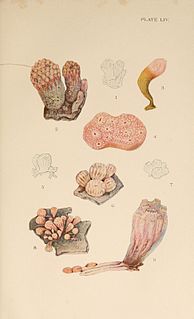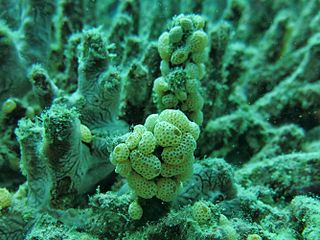| Morchellium | |
|---|---|
 | |
| Morchellium argus , illustrations at top | |
| Scientific classification | |
| Kingdom: | Animalia |
| Phylum: | Chordata |
| Subphylum: | Tunicata |
| Class: | Ascidiacea |
| Order: | Enterogona |
| Suborder: | Aplousobranchia |
| Family: | Polyclinidae |
| Genus: | Morchellium Giard, 1872 [1] |
| Species | |
Morchellium is a genus of colonial sea squirts, tunicates in the family Polyclinidae.
A genus is a taxonomic rank used in the biological classification of living and fossil organisms, as well as viruses, in biology. In the hierarchy of biological classification, genus comes above species and below family. In binomial nomenclature, the genus name forms the first part of the binomial species name for each species within the genus.
In biology, a colony is composed of two or more conspecific individuals living in close association with, or connected to, one another. This association is usually for mutual benefit such as stronger defense or the ability to attack bigger prey. It is a cluster of identical cells (clones) on the surface of a solid medium, usually derived from a single parent cell, as in bacterial colony. In contrast, a solitary organism is one in which all individuals live independently and have all of the functions needed to survive and reproduce.
Family is one of the eight major hierarchical taxonomic ranks in Linnaean taxonomy; it is classified between order and genus. A family may be divided into subfamilies, which are intermediate ranks between the ranks of family and genus. The official family names are Latin in origin; however, popular names are often used: for example, walnut trees and hickory trees belong to the family Juglandaceae, but that family is commonly referred to as being the "walnut family".









